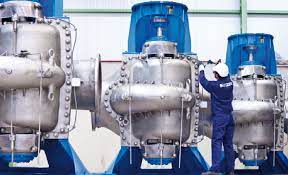
|
SCHEDULE : 07-08 JUNI
What You Will Learn |
|
|
|
|
|
Course Outline
|
|
|
General Pump Principles
ü Special Pumps ü Reciprocating Pumps ü Rotary Pumps
|
|
Centrifugal Pumps
- Types
ü Axial Flow
ü Mixed Flow
ü Radial Flow
- Application and performance considerations
- Pump performance curves
- Developing system-head curves
- Developing pump performance curves for parallel/series operation
- Pump components and variations in design
- Centrifugal pump types and selection criteria
- Applicable standards and specification selection
- Centrifugal pump installation
- Piping installation guidelines
- Pump driver considerations
- Limitations, operating/maintenance considerations and trouble-shooting
- Application and performance considerations
- Installation considerations
- Limitations, operating/maintenance considerations and trouble-shooting
Reciprocating Pumps
- Types
ü Piston/Plunger
ü Diaphragm
- Application and performance considerations
- Selection criteria
- Flow characteristics
- Mechanical components
- Piping installation guidelines
- Pulsation and vibration considerations
- Pump driver considerations
- Applicable standards and specification selection
- Limitations, operating/maintenance considerations and trouble-shooting
Rotary Pumps
- Types
ü Vane
ü Piston
ü Peristaltic
ü Gear
ü Lobe
ü Screw (Progressing Cavity)
- Basic Principles
ü Gear Pumps
ü Single and Multi-Lobe Pumps
ü Single-Lobe Pumps
ü Components
ü Operation
ü Displacement
ü Pressure Capability
ü Torque and Power Requirements
ü Pump Geometric Variations
- Pump Manufacturing Processes
- Designations and Specifications
- Elastomers
- Pump Testing, Sizing and Failure Identification
- System Design Components, Considerations and Processes
- Applications
- Installation and Trouble-shooting
- Applicable standards and specification selection
Energy Reduction in Pumping Systems
- Opportunities for Potential Savings
- Pump Economics
- Designing a Pumping System for maximum efficiency
- Pump Performance Characteristics
- Avoiding Excessive Capacity and Total Head Margins
- Selecting the most efficient pump
- Using Variable Speed Drives
- Proper Pump Maintenance
Piping Systems
- Terminology
- Steel Lines
ü Material Specification
ü Pipe Manufacturing Methods
- Non-Metallic Lines
ü Material Specification
ü Joining Methods
- Standards, Codes and Recommended Practices
- Pump piping design practices
- Suction and discharge considerations
ü Manifolds
ü Components
ü Recycle lines and PSV requirements
Lessons Learned and Practical Solutions
- Water injection pump considerations
- Shipping pump considerations
- Oil Transfer Pump considerations
- Energy Reduction Considerations
- Economic consider
- Field examples
|
Overview of Compressors
ü High-speed "separable" units ü Low-speed "integral" units
ü Vane units ü Screw units
|
Centrifugal Compressors
- Major components
- Operating principles
- Typical Compressor Installations
- Process considerations
- Series and parallel operation
- Factors affecting performance
- Performance map interpretation
- Surge control and stonewall considerations
- Piping installation guidelines
- Preventive maintenance and trouble-shooting
- Applicable standards and specification selection
Positive Displacement Compressors
- Rotary compressors and blowers
ü Operating principles
- Lobed blowers
- Sliding-vane
- Screw
- Liquid piston
ü Performance considerations
- Reciprocating compressors
ü Major components
ü Operating principles
ü Design considerations
ü Pulsation and vibration considerations
ü Piping installation guidelines
ü Preventive maintenance and trouble-shooting
- Applicable standards and specification selection
Application of Compression Theory and Practical Solutions to Common Problems
- Determining Compressor Parameters'
- Developing a Compressor Performance Curve
- Determining the Operating Range of a Compressor
- Effects of adding Clearance on Compressor Performance
- Effects of Speed on Compressor Performance
- Determining the Safety Device Set Points
- Designing a Multi-stage Compressor
Internal Combustion Engine Drivers
- High speed reciprocating engines
ü Spark ignition vs. compression ignition
ü 2-cycle vs 4-cycle
ü Naturally aspirated, superchargers and turbo-expanders
ü Carburation vs. fuel injection
- Auxillary systems
- Installation guidelines
- Environmental considerations
- Preventive/predictive maintenance and trouble-shooting
- Applicable standards and specification selection
Electrical Motors
- Basic principles and operating considerations
- Three-phase induction motors
- Three-phase synchronous motors
- Voltage selection
- Equipment specification
- Performance considerations
- Instrumentation
- Motor selection
- Electrical Installation in Hazardous Locations
- Commissioning and start-up
- Maintenance, surveillance and trouble-shooting
Driver Selection
- Size availability
- Purchase price Vs total life cycle cost
- Installation costs
- Fuel considerations
- Power requirements
- Environmental considerations
- Final selection





